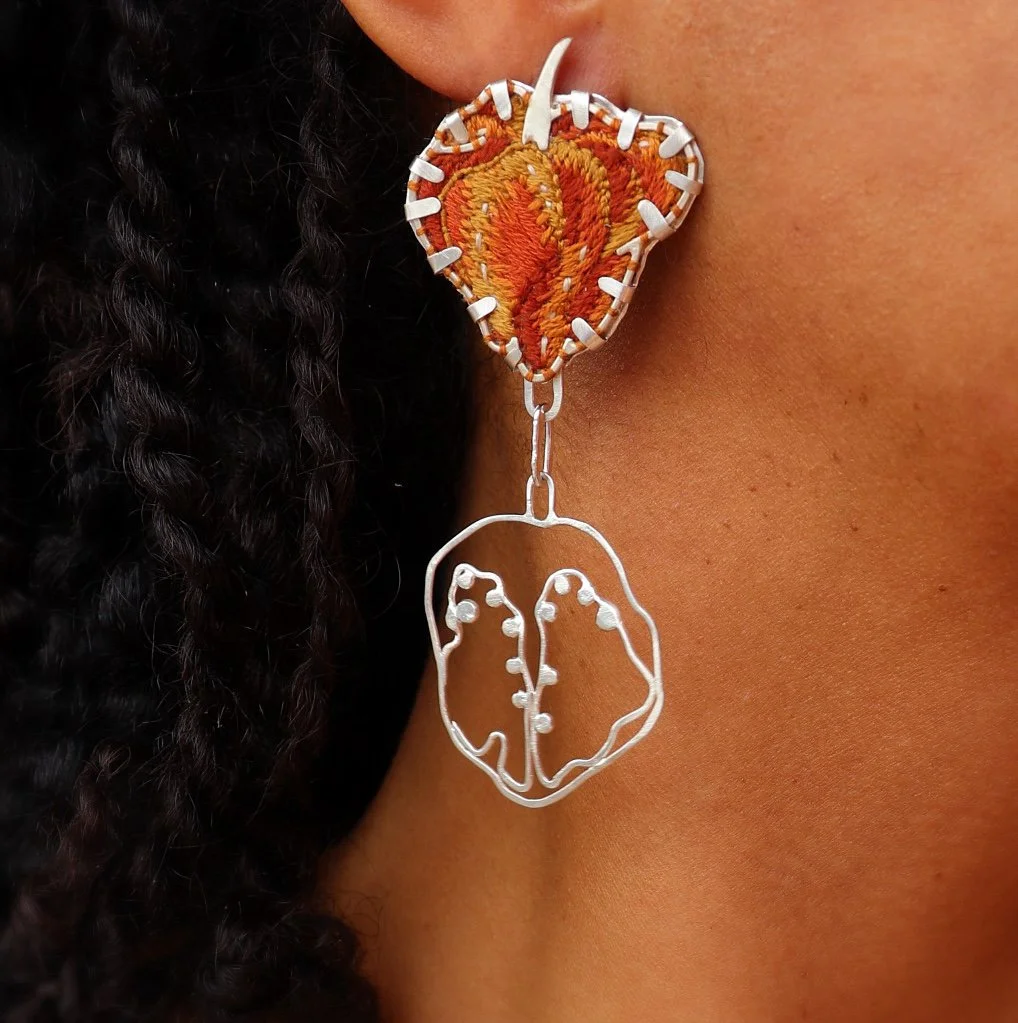
Nanette Pengelley
she/her
Durham, NC, USA
Nanette Pengelley is a queer, Jamaican-American jeweler, metalsmith, and educator from south Florida. She studied in Boston, and Florence. After graduating from Massachusetts College of Art and Design in 2015 with her BFA in Jewelry and Metalsmithing, Nanette has been exploring her practice within her brand, Hew Jewelry. She currently lives in Durham, North Carolina, and spends summers teaching in New England.
“My work centers around the use of sustainable production. When I integrate found objects and up-cycled materials alongside semi-precious materials, I introduce these discoveries into a transitive context. As a result, my process is a derivative of my environment. Through experimentation, I endeavor to locate myself in my surroundings, as an artist—as a person. My work is shaped by the materials that I encounter, and my own unique craft methods. In this way, my experiences, my ethics—my very way of walking through the world are all carried forward with the wearer, through the act of making.”
How does your work relate to the theme connection?
“Spicy peppers, hot sauce— even seasonings, period, are commonly associated with black culture, but the scotch bonnet has a special place in every Jamaican’s heart— as well as their history.
The Taino, a subgroup of the Arawak, traveled over from the Orinoco River Valley, located in present day Venezuela, to Xamayca (Jamaica) on big canoes. They brought with them a variety of staples, among them were scotch bonnets and barabicu— their traditional style of cooking over an open pit fire.
The Taino lived in harmony until the arrival of Christopher Columbus in 1494, who enslaved, tortured, and decimated their population. When the Taino genocide was complete, Spain began importing enslaved people from Africa to replenish their labor force. By 1655, Spain surrendered Xamayca over to the British, freeing their slaves in the process. These freed slaves took shelter in the wild and mostly unsettled central terrain of the island, and became known as maroons. The maroons survived alongside the last of the Taino, the remaining people who managed to escape the Spanish into the mountains years before and had gone largely unnoticed by them ever since. They learned the Taino way of cooking, seasoning, and preparing food found on the island— and thus the tradition of ‘jerk,’ seasoning meat with scotch bonnets and other spices and then cooking it in a barbecue was born.
The scotch bonnet is a symbol of my connection to my identity, my culture, and my family history. My father, a Jamaican chef, taught me an appreciation and also a deep respect for this hot pepper. I learned how to cook with it, but was also punished for talking back with it. I learned to be proud to be able to endure it’s heat, even with tears running down my face. In our house, the scotch bonnet is a symbol of tradition and resilience, handed down to me by my family, and to them by a people who’s culture endures even beyond their genocide at the hands of white colonialism. It’s a symbol of endurance and strength— a connection to both past and present."
"How hot?", Old pillow case, embroidery thread, sterling silver, 3” x 1.5”, 2024 NYCJW24 @ UrbanGlass, Francely Flores
“My work often draws inspiration and meaning from my identity as a queer black woman. Everything is connected— who I am influences how I work, and what I prioritize, who I want to see my work, and who I want to be seen by my work. Both my production and creative processes are rooted in not creating waste, and causing the least amount of harm to my environment and community as possible. I donate 20% of my weekly sales to mutual aid, and try to use my platform to help educate my online community about ways they can contribute as well. I feel strongly that my connection to my identity and community is what makes it both possible and necessary for me to work in this way."
What role does connection play in your creative process?
NYCJW24 @ UrbanGlass, Francely Flores
NYCJW24 @ UrbanGlass, Simon Leung
What connection(s) does your queerness make to the world around you?
"My queerness connects me to a broad community of people who feel largely unseen and underrepresented, or when they are seen, it is as an ‘other.’ There’s so much beauty in the parts that get ignored, in the unseen, and that is the fundamental basis of my work. My queerness allows me to see these things for what they are, and the community around me understands that, I think it speaks to them as it does to me."
[queerphoria]v4 @ ECU Symposium










